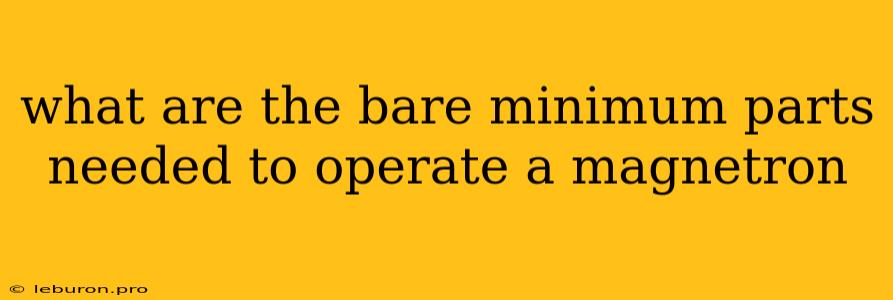The heart of a microwave oven, the magnetron, is a fascinating device that harnesses the power of electromagnetic waves to heat food. While its operation might seem complex, understanding the fundamental components required for its function reveals a surprisingly straightforward mechanism. This article explores the bare minimum parts needed to operate a magnetron, delving into their roles and how they work together to generate microwaves.
Essential Components of a Magnetron
At its core, a magnetron is a vacuum tube that converts electrical energy into microwave radiation. To achieve this, it relies on a specific set of components:
1. Cathode:
The cathode is the primary source of electrons in the magnetron. It's typically a heated filament made of a material with a low work function, like tungsten. This material emits electrons when heated, creating a cloud of negatively charged particles.
2. Anode:
The anode acts as a collector of electrons, surrounding the cathode and creating an electric field. It's usually a cylindrical structure with slots or cavities machined into its outer surface. These slots are crucial for generating microwaves.
3. Magnetic Field:
A strong magnetic field is essential for guiding the electrons emitted by the cathode. This field is generated by permanent magnets or electromagnets placed around the magnetron. The magnetic field forces the electrons to travel in a curved path, ultimately interacting with the anode's cavities.
4. Cavity Resonator:
The cavity resonators are the key components responsible for producing microwaves. These are hollow, metallic structures built into the anode. The electrons, as they are forced to move in a spiral path by the magnetic field, interact with these cavities. This interaction causes the electrons to oscillate at a high frequency, generating electromagnetic waves within the cavities.
5. Waveguide:
The waveguide is a metallic tube that channels the microwave energy generated by the magnetron to the microwave oven's cooking chamber. It's designed to prevent the microwaves from escaping the oven and to efficiently transmit them to the food.
The Magnetron in Action: How It Generates Microwaves
The process of microwave generation starts with the heated cathode emitting a cloud of electrons. These electrons are then accelerated by the electric field towards the anode. However, the magnetic field created by the magnets forces the electrons to move in a circular path, preventing them from directly reaching the anode.
As the electrons spiral around the cathode, they pass near the cavity resonators in the anode. The interaction between the electrons and the cavity walls sets up a resonant frequency within each cavity. This resonance causes the electrons to oscillate at a specific frequency, leading to the generation of electromagnetic waves.
These waves are then channeled through the waveguide to the cooking chamber. Inside the chamber, the microwaves interact with the water molecules in the food, causing them to vibrate. This rapid vibration generates heat, cooking the food.
The Bare Minimum: Understanding Essential Components
While other components might be present in a microwave oven, such as a power supply, a control system, and a safety interlock, the bare minimum parts needed to operate a magnetron are the cathode, anode, magnetic field, cavity resonators, and waveguide. These five components together are responsible for the crucial process of converting electrical energy into microwave radiation, making microwave ovens possible.
Conclusion
The magnetron, with its seemingly complex operation, relies on a surprisingly simple set of components working in unison. Understanding the roles of the cathode, anode, magnetic field, cavity resonators, and waveguide allows us to grasp the fundamental principles behind microwave generation. These bare minimum parts are essential for the successful operation of any magnetron, driving the ubiquitous microwave ovens that have become a staple in modern kitchens.
